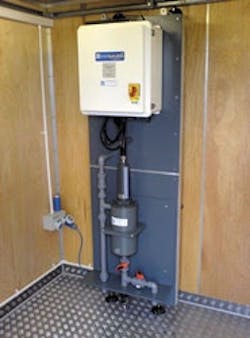Simpler Water Intake Monitoring System Reduces Frequency of Site Visits
Until recently, drinking water utility managers have relied on traditional, wall-mounted systems to monitor water quality upstream of extraction points. However, Severn Trent Water found that these complex systems require a high level of maintenance and frequent calibration.
Natalie Horton, works manager at Severn Trent Water, was becoming increasingly frustrated with these problems associated with traditional monitoring systems. She heard that the UK Environment Agency uses YSI sondes to monitor water quality in rivers, so she approached YSI Hydrodata to discuss the possibility of using the sondes for intake protection.
The difference
The heart of the HydroSAM is a multi-parameter probe known as a ‘sonde,’ thousands of which are in use all over the world as in situ water quality loggers in both freshwater and marine applications. The HydroSAM is designed to replace older water quality monitoring systems with a compact and efficient system, and has been designed for minimum maintenance and long-term deployment.
In response to Horton’s request, a sonde was installed directly in the Severn River, upstream of the Shelton water treatment works near Shrewsbury, England, on a three-month trial. Severn Trent Water was one of the first utility companies to try HydroSAM. “The performance of the new water quality monitor has been absolutely brilliant,” said Horton.
Severn Trent Water’s HydroSAM monitors pH, temperature, conductivity, turbidity, dissolved oxygen, and ammonia. It is also possible to add sensors for chlorophyll and blue-green algae if desired.
Prior to the trial, Horton admitted to a fair degree of skepticism over the instrument’s ability to cope with occasional high levels of biological fouling. She knew that when the instrument’s water quality sensors were submerged for long periods of time, there was a possibility that organisms in the water could adhere to the sensors and affect the quality of the data.
Continuous monitoring at a lower price
Following the success of the trial, Severn Trent Water ordered a full HydroSAM system, which has been permanently installed ten miles upstream of the water intake. The full system includes a YSI 6600 V2 sonde and cable, a flow-through sample chamber, data logger, and data transmission capability.
The system provides almost continuous data to the Shelton works. Operators have the ability to dial in to the unit from anywhere, or visit the site and collect data with a portable computer. Alarm conditions have been set and the unit will issue alarms via the PMCS (Severn Trent’s alarm and control system) should those conditions arise.
The reliable performance of the YSI HydroSAM , whether close to the plant or in remote locations, has led to savings in labor costs for Severn Trent Water. A traditional system can require one hour of maintenance almost every day. With average labor costs in the UK at ?26, maintenance costs for a traditional system for one year are around ?9,000 (or more than US$15,000).
With the HydroSAM, maintenance and calibration visits are reduced to one every six to eight weeks. This yields a total labor cost of approximately ?225 (US$448) per year, a significant savings.
Since the trial, Horton has become a risk and safety manager for water supply at Severn Trent Water. “The main benefit for us [with regards to the HydroSam system] has been the reduced requirement for calibration and maintenance; site visits used to be necessary every week, but now a simple six-week calibration check is all that is needed.”
Note: YSI’s multi-parameter sondes are currently undergoing evaluation in order to achieve MCERTS accreditation for monitoring treated wastewater and receiving waters. MCERTS is the UK Environment Agency environmental monitoring certification scheme.
Darren Hanson is a regional manager for YSI Hydrodata. He can be reached at +44 (0)1462 673581 or by email at [email protected].
